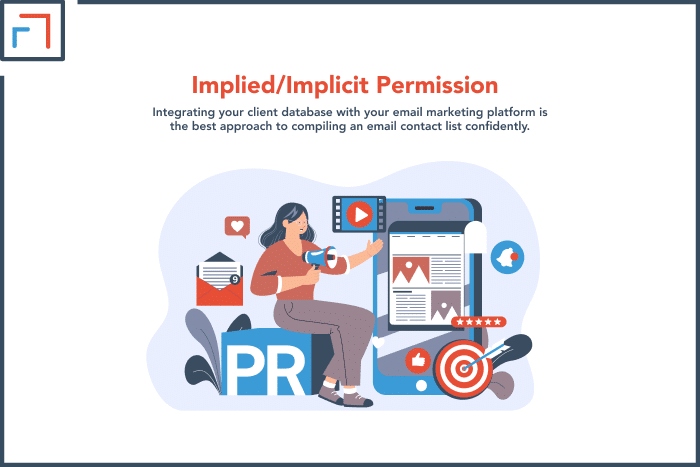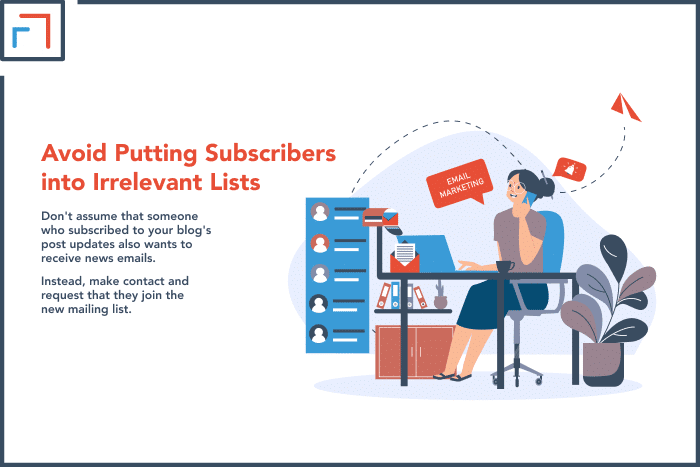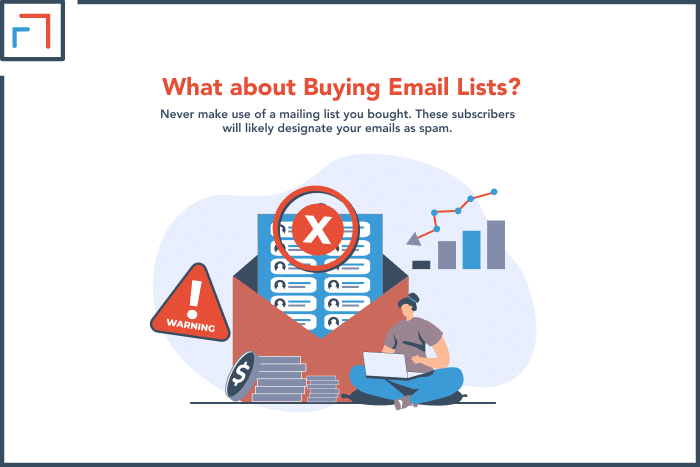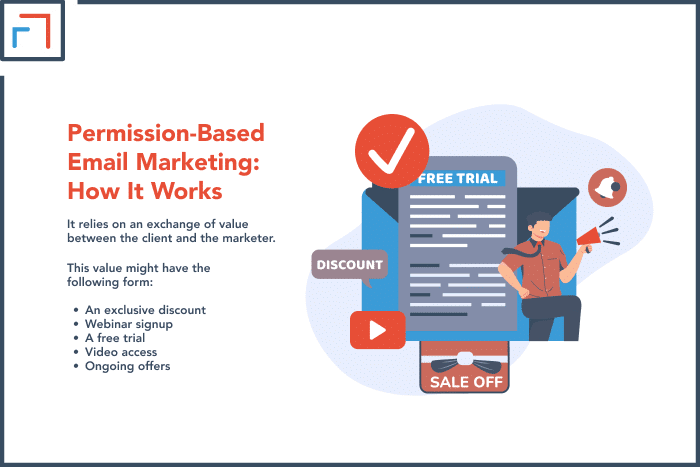Have you heard of the legal restrictions like PECR, CASL, and CAN-SPAM? You may violate all these if you send marketing emails without permission. Also, your emails may end up in spam folders. If you want ways to get permission, we’ve got you covered!
To get permission to send marketing emails, either send a confirmation opt-in email upon their successful sign-up or add a checkbox on the website form. The confirmed opt-in (double opt-in), where one sends an email with a confirmation link to the user, is more effective than the latter solution.
We all know how sending emails to people who never agreed to receive them in the first place can hamper your brand reputation. That’s why this article outlines the most effective ways to get permission to send marketing emails to save you from getting spammed!
3 Ways to Get Permission to Send Marketing Emails
You should only send emails to recipients who have consented to receive them to safeguard your reputation and guarantee that your messages are correctly delivered.
Adhering to these best practices will lessen your chance of experiencing blocklisting incidents and bad sending statistics.
| Implicit Permission | The user enters an email ID for purchase or free trial → You clarify them about sending emails → You send marketing emails for related products or services → You also provide an opt-out option. |
| Explicit Permission | Add checkbox to sign-up form → Get their explicit consent to send marketing emails |
| Double Opt-In | User registers for your email list → You send them a confirmation link via email → They will officially subscribe to the email list upon clicking that link → It ensures that users fully agree to receive your marketing emails. |
1. Implied/Implicit Permission
If you have a commercial relationship with someone, most likely because they are a regular customer, give to your charity, or are an active member of your website, club, or community, you have implied consent to email them.
Integrating your client database with your email marketing platform is the best approach to compiling a list of people you can email confidently.
If your customer data is stored in CRM systems like Salesforce or e-commerce platforms, it may be readily incorporated into your ESP account.
Similarly, you can quickly link over 500 accounting, billing, e-commerce, and CRM applications using third-party apps like Zapier, which can then integrate your customer data.

2. Explicit Permission & Double Opt-In
You can request to send marketing emails when someone buys your product or services.
To let the customer know they should anticipate a message from you, include a check box asking for their consent to email them or a button like, “Yes, subscribe me to your emails!”
Implementing a confirmed opt-in is one technique to ensure you have prospects’ consent before emailing them.
When you add confirmed opt-in, often called double opt-in, you send new users an email containing a special confirmation link that they must click to subscribe to your email list.
Also, this aids in avoiding spam traps.
Opt-in email marketing helps you protect user privacy. Apart from that, you are free from high-cost legal liabilities by providing the double opt-in safeguard.
Email Marketing Consent Best Practices
You can ask prospects to subscribe to your email list so you don’t have to add them to your lists manually. But how do you go about it?
- Incorporate a subscribe option at the checkout if you run an online store
- Send them a thank-you email for their interest and a link to a page on your website where they may subscribe if you gather emails at an event
- Make a page with a newsletter block for your website. Then, you can link to that page in postings on social media, private emails, and other places
- Include a banner on your website encouraging people to subscribe
- If you have multiple mailing lists, create a newsletter block for each and use the description to clarify how subscribers can sign up
Avoid Putting Subscribers into Irrelevant Lists
As long as the kind of email you’ll be sending stays the same, importing your existing list when switching email marketing platforms is acceptable.
However, you shouldn’t assume that someone who subscribed to one form of marketing email wants to receive another.
Don’t assume that someone who subscribed to your blog’s post updates also wants to receive news emails. Instead, make contact and request that they join the new mailing list.

Add an Easy-to-access Unsubscribe Link
You must provide receivers with a simple mechanism to opt out to ensure you only contact people interested in getting your messages.
Users and leads can inform you that they do not want to receive your emails by clicking on an unsubscribe link that is prominently displayed without causing any harm to your sending reputation.
In addition to reducing spam complaints, a clear unsubscribe link also helps.
Get Rid of Uninterested Users from the List
Permission isn’t a commitment. Even if someone permits you to send them emails, you should delete them from your list if they stop using your product and responding to your communications.
A person should be let go if they haven’t signed in or opened your email in over six months.
What about Buying Email Lists?
Never make use of a mailing list you got for free or bought. These subscribers will likely designate your emails as spam because they haven’t indicated they wish to receive them.
Fake email addresses are also commonly found in purchased lists. Email filters may flag all your emails as suspicious if you’ve had spam or a list of phony email addresses on your account.

Importance of Getting Permission to Send Marketing Emails
Email marketing must adhere to certain regulatory guidelines under the General Data Protection Regulation (GDPR).
For marketing messages to be transmitted to consumers, they must give informed consent. Email marketing is likewise subject to this restriction.
Some businesses purchase email addresses and send emails to thousands of recipients. They merely have low conversion rates and squandered resources at the end of the day.
Furthermore, buying emails harms the company’s reputation. The majority of these emails are also marked as spam.
Some businesses still take chances and collect email addresses from different sources to connect with a larger target audience. (Do check out my article on where can you collect emails for marketing?)
However, this old-fashioned and unethical email collection method may lead to incurring fines, other penalties, and serious deliverability issues.
Sending marketing email blitzes needs authorization. Every nation has regulations that email marketers must abide by, and most demand that recipients consent before receiving marketing emails.
Sending emails to someone without their permission can also cause them to mark you as spam.
As a result, emails from your domain may be delisted, and you may be barred from email marketing platforms.
Further, it can also land you in legal trouble. I’ve covered more on this in my article on the legalities of sending marketing emails without permission.
Permission-Based Email Marketing: How It Works
Since it relies on an exchange of value between the client and the marketer, permission-based email marketing is a smart choice. Consent to receive emails is requested from them.
You provide the customer with something of value in exchange. This value might have the following form:
- An exclusive discount
- Webinar signup
- A free trial
- Video access
- Ongoing offers

Would You Heckle Someone in Real Life? Then Why Over Emails?
An essential component of email marketing is ensuring you have consent to send messages to specific people.
If you aren’t the type who heckles someone in real life, then don’t be the person who does so over emails behind the wall of anonymity.
Not only do you garner a bad reputation for your business, but it can also land you in serious legal trouble.
Companies that use email marketing effectively generate large sales and revenue from their campaigns and have high open and click-through rates.
There you have it, the tips you need to get consent to send emails for the best results from your company’s marketing efforts.
